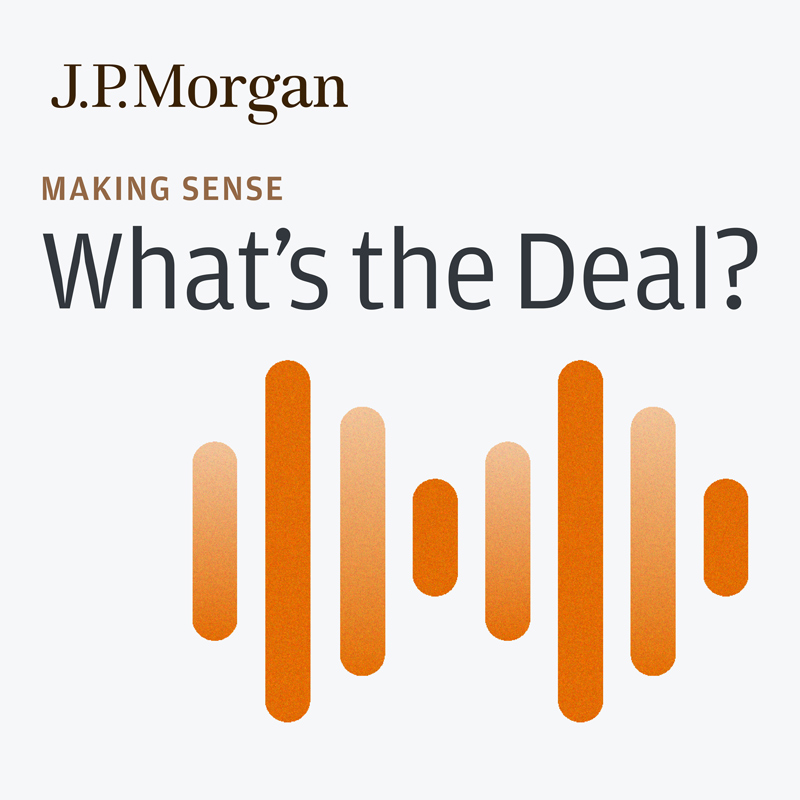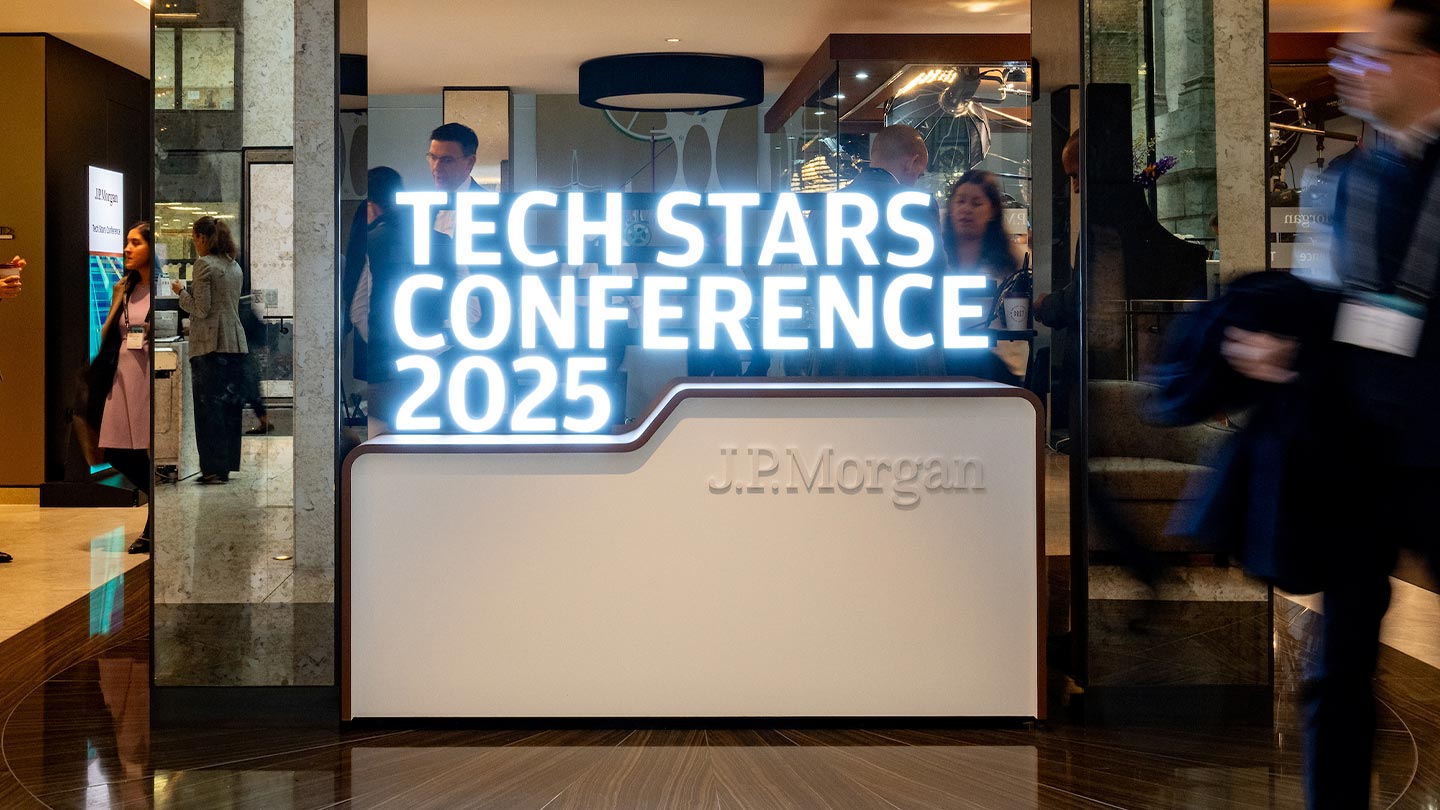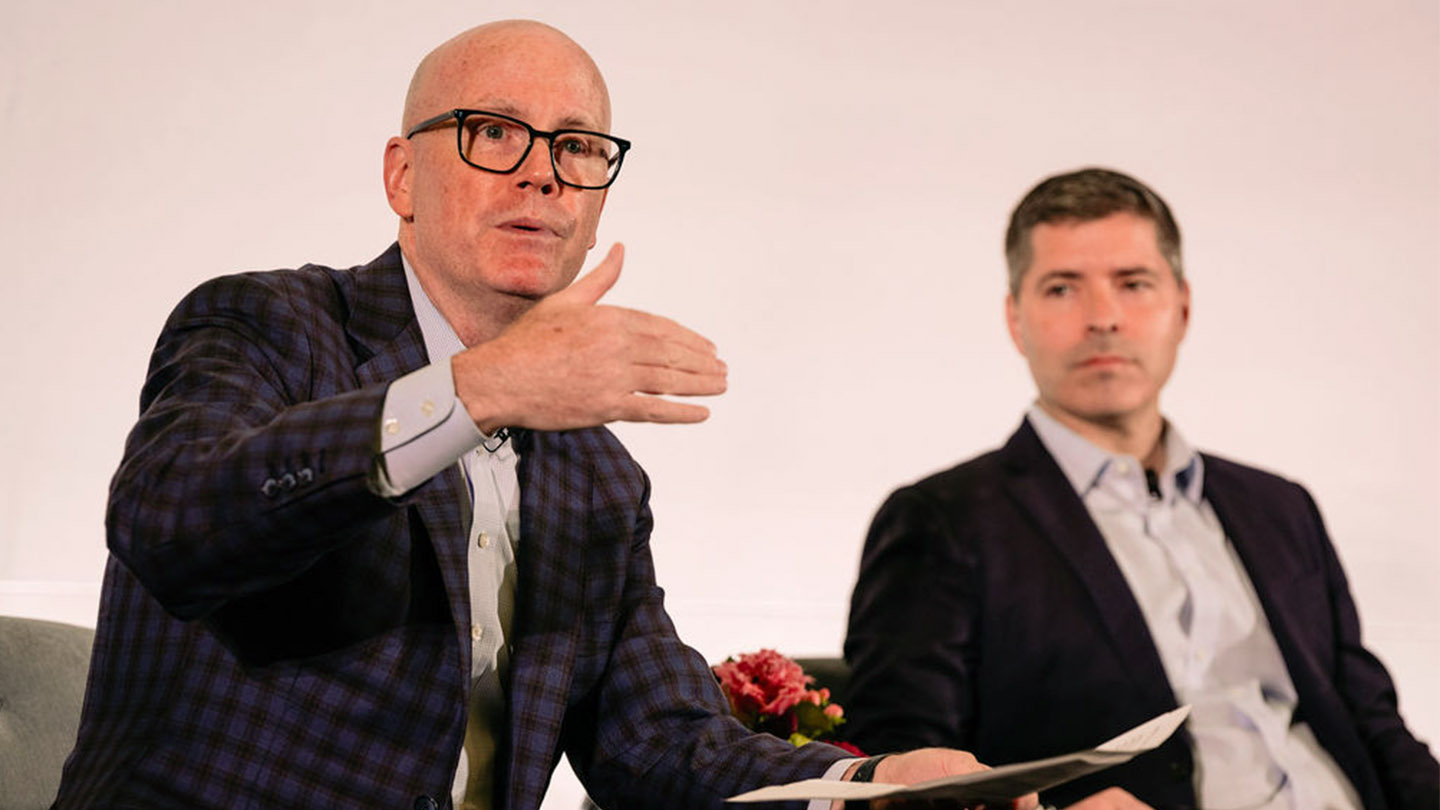Navigating volatility: M&A and leveraged capital markets update
[Music]
Evan Junek: Hi, you're listening to What's the Deal?, our investment banking series here on J.P. Morgan's Making Sense podcast. I'm your host, Evan Junek, global head of Corporate Finance Advisory at J.P. Morgan. Today I'm joined by Jay Hofmann, head of North American M&A, and Brian Tramontozzi, head of North American Leveraged Finance Capital Markets. Jay and Brian, welcome to the podcast.
Brian Tramontozzi: It's great to be here.
Jay Hofmann: Thanks, Evan.
Evan Junek: Well, we've got a lot to unpack today. We've got universal tariffs in place. We've got 145% tariffs on China. We've got tariffs on steel and aluminum, tariffs on auto and auto parts. We've got equity capital markets, the S&P 500 as of this recording, which is taking place on the 21st of April, down roughly 10% year to date. And we'll talk a little bit more about how the debt capital markets have responded as well. But maybe I'll start with you, Brian, because you're gonna give us the most up-to-date moment to moment view on what the capital markets are thinking. Why don't you unpack for us what's going on in the debt capital markets in your world, from as you see it, with this very volatile and uncertain backdrop?
Brian Tramontozzi: Sure. So I'd say this, markets are behaving very rationally. From prior to the noise at round tariffs to where we are today, the high yield index is only about 75 basis points wider. By comparison, the first 13 days after COVID, the high yield index moved by over 600 basis points. So the market is reacting very passively to the news. Part of the reason for that is that we came into 2025 with record liquidity in high yield, and that hasn't changed. While, yes, we had large outflows during the last two weeks, every month there are sizable inflows from coupon generation into high yield. And in fact, today versus where we started the year, liquidity is arguably higher in the leveraged loan market. Volumes have been subdued, there hasn't been a single deal clear the market in the last two weeks. There are a couple of deals that launched but are on hold until conditions stabilize. And I think primary reason for that is liquidity in the leveraged loan market is not quite as good as we're seeing in the high yield market, and therefore prices haven't yet recovered to the same degree that the high yield market has seen in the last three or four days. But we do believe that that market too is orderly, and therefore, for the right borrower, there would be an ability to get a deal done. It's just at a rate that's elevated from where it would've been three or four weeks ago. Now, there's a third market I want to talk about, which is private credit. And as many know, J.P. Morgan recently increased its private credit platform from $10 billion to $50 billion. And really what we're going to see, if the market's high yield and leveraged loans don't rally back, private credit is gonna be where we see the bulk of, I would suspect, M&A activity to take place over the course of the near future. And in fact, we're already seeing that take place now, and J.P. Morgan is gonna be leading the charge in many of those financings as they get announced.
Evan Junek: Can I ask you to maybe expand a little bit on how investors today are thinking about Treasury rates? I appreciate in your market that's a little bit less of a focus on a day-to-day basis, but one of the topics that's been coming up with clients every day is what's been going on in the Treasury markets, especially on the long end of the curve. We've not seen Treasury rates fall as much as we've historically seen in periods of elevated market uncertainty.
Brian Tramontozzi: So in normal times, Treasuries rally due to flight equality of investors owning the safe and of government securities. That really hasn't happened in this go-around, and I think the reason for that is there's so many uncertainties now pushing on Treasuries, inflation, foreign government, liquidation of potential foreign government, liquidation of Treasuries, heavy supply of Treasuries funding our national deficit, and then finally some technicals around hedge fund unwinds. It's not clear that we will expect to see a rally in Treasuries over the next several days, several weeks. So our market really right now is just trading on spread. And what we're seeing on spread is spreads are holding in quite well, both in loans and high yield. And the direction of spreads is really gonna be a function of any further news around tariffs and the impact on business and economic outlook.
Evan Junek: So maybe shifting over to you, Jay, why don't you talk a little bit about what you're seeing in the M&A environment today. Obviously we've got Brian's perspective, which feels very real time, very much of the moment. M&A is a little bit more sentiment driven, and would love to hear what you're hearing from clients and the kinds of activity you're seeing in the market right now.
Jay Hofmann: Yeah, you bring up a great point, Evan, which is that the M&A market tends to respond to what happens in capital markets on a time lag. And sometimes that time lag is a few weeks, sometimes it's a few months. And that's basically what we're seeing right now. It's quite a bit of a wait and see attitude. And it's not unlike what happened at the beginning of COVID when there was a big discontinuity in obviously the global macroeconomic environment. People didn't really know what was going to happen. And so as a result, they kind of played a game first of thinking week by week, what do I do? If I'm in the middle of a transaction, do I progress it? Well, the answer generally is yes, let's keep going, but let's see what happens week by week. How are the markets doing? What's going on in my own business? What do the prospects look like? On the other hand, it's not a great time to start a transaction. So what we have seen is a lot of folks who might otherwise have been thinking about starting things in mid-April have pushed off that decision-making. They haven't necessarily pushed it off a long time, although it does vary quite a bit by industry and even subsector. But decisions that people may have been thinking about taking in mid-April and now sort of pushed off to early to mid-May. And we'll have to see, when we get there, what people do.
Evan Junek: You mentioned differences between sectors or industries. Any notable commentary in there that'd be more specific?
Jay Hofmann: Yeah, look, not every industry or sector is affected by tariffs in the same way. So the first question that our clients have been asking themselves is, is my business affected by tariffs or the business of the company that I'm thinking about buying? And if the answer to that is no, they have to ask the second-order question, which is, okay, but if all the talk around the potential recession actually comes into play, is my business affected by the recession or recession? What about the target business? Now, not all businesses are equally affected by tariffs nor recession, right? So if you look at things that tend to have heavier services content, which could be potentially in healthcare, they may be more domestic, not cross-border. Again, healthcare services might be a good place to look. Sometimes technology services. There are some consumer product sectors that are not as affected by what happens globally. We seem to see a little bit more continued momentum there. On the other hand, you know, anything that has to do with manufacturing of physical products, and particularly electronics where there's been so much offshoring to Asia and China over the last 30 or 35 years, those are sectors where people, where executives are really questioning whether this is an entire restructuring of the global economy. And if that's your perspective, then obviously your approach is to just sort of stand pat and focus on your own business before you think about the additional risk you might take on in an M&A transaction.
Brian Tramontozzi: And I can add a point there too, so we're seeing something very similar in the high-yield and leverage loan market with lenders pushing their preferences toward defensives and non-economically sensitive sectors. There's an outperformance of double Bs versus triple Cs and an outperformance of defensives versus cyclicals.
Evan Junek: And interestingly enough, as my team has done a lot of work around looking at the impact of tariffs across sectors, both in the equity markets and strategically, I'd say we've seen very much the same thing taking place in the equity markets, which is to say rational. Again, it's hard to kind of step back when you've got so much red on the screen and see the forest from the trees, but when you do dig into it, you do see the traditional sectors, the utilities, the consumer staples. These are sectors that have generally outperformed real estate and other, another sector that's generally outperformed in this environment. I think indicating that as much volatility as we've experienced in recent weeks, it is orderly to some extent and to some extent rational in terms of how investors are operating. Maybe let's talk a little bit about the global dynamic for a second here, because of course, so much of what we're talking about with trade and tariffs impacts the relationship between onshore and offshore U.S. Jay, maybe I'll point to you. I'd say if we were having this conversation three, four, five months ago, we'd be talking about things like relistings, right? This massive wave of capital that continues to find its way into the U.S. Companies looking at everything from separations to carve outs, trying to take advantage of premium valuations in the United States. Has that turned around? Has that reversed? Is this a pause? Too soon to say? What are you seeing?
Jay Hofmann: I, I think the place to start, Evan, is that if we were having this conversation in that timeframe, animal spirits would've been catchphrase, right?
Evan Junek: Yes, animal spirit.
Jay Hofmann: And unfortunately, that's not the catchphrase anymore. And you're right. Historically, the U.S. capital markets have obviously been more highly valuing a lot of different types of companies than foreign markets, particularly Europe. And frankly, you know, year in, year out, more or less, the U.S. M&A market accounts for about two thirds of global volume. So you know, if we sneeze here, other places catch a cold, right? I would say that prior, or in that timeframe that you were talking about, there was definitely a point of view from a lot of European companies. They wanted more U.S. exposure. The point of view is that the U.S. economy was gonna outperform other economies, and that if there were gonna be tariff barriers that were put up, it would be better to own businesses in the U.S. than to try to export into the U.S. I don't think that's the case anymore broadly speaking. We've heard from my colleagues in Europe and from some clients in Europe that they've done a bit of a 180 in terms of wanting to buy businesses in the U.S. right now. And it's not particularly surprising why, right? There's, number one, a lot more uncertainty here about where the economy's going. There's difficult transatlantic political dynamics. And then you put on top of that, there's a point of view that, in Europe, perhaps there'll be some better opportunities if in fact this is gonna lead to more of a reindustrialization of Europe. I would say less impact, to be honest with you, in Asia and Latin America.
Evan Junek: Yeah.
Jay Hofmann: Because the corridors, frankly, are not as active from an M&A standpoint.
Evan Junek: Right. You heard me talk about the S&P 500 being down about 10% year-to-date. Again, this is as of April 21st.
Jay Hofmann: Down two more points this morning.
Evan Junek: Down two more points this morning. If you look at the rest of the world, excluding the U.S.-
Jay Hofmann: Mm-hmm.
Evan Junek: ... markets are up about 6%. So 16 percentage point delta between the U.S. and the rest of the world. That is almost by construction in part due to capital flows out of the U.S. into the rest of the world.
Brian Tramontozzi: Still trading at a much higher premium.
Evan Junek: Yeah, and we still trade at a much higher premium. Some of the fundamentals of the trends that we were talking about just a moment ago, with respect to the bias towards wanting to be in the United States, technically a lot of those fundamentals still exist, still a large PE premium on US companies. The S&P 500, again over roughly 20 times PE right now. Probably a little lower than that as of this morning. But these are still healthy multiples in global terms. But it does seem to be that there is a little bit of a shift taking place. Whether it's in the Treasury market, whether it's in the equity markets, all of these seem to suggest that there is a sell America theme at the moment, and we'll see how long if that persists, or whether that ultimately reverses. I want to shift gears a little bit and talk about private credit. Brian, as you mentioned earlier, we're re-upping our commitment in private credit to $50 billion. Can you talk a little bit about what that really means, what are we're doing in terms of that initiative, and how it's impacting your markets and our strategic dialogue with clients?
Brian Tramontozzi: Sure. So J.P. Morgan has been in the private lending business since 1799 through its predecessors, starting with The Manhattan Company. A few years ago, we created a direct lending business within leverage finance of $10 billion and we've recently announced that we're gonna take that program to $50 billion. When in combination with our co-lenders, that program's roughly $65 billion in size. That makes us one of the large players in that business, and we want to be a leader in everything we do. What we have seen in changing markets, and used 2022 as an example, when the broadly syndicated markets pulled away from underwriting leveraged buyouts, the private credit market was very much open for business and was the source of, in the second half of '22, the majority of financing for M&A. And I would suspect, as we look at market conditions today being uncertain, that the private credit market very well could be the source of the majority of the financing, at least for the foreseeable future until this market volatility subsides.
Jay Hofmann: I agree with Brian. It has been a tremendous lubricant for the M&A market, as you pointed out. I mean, it's just driven a lot more LBO activity that we would've otherwise seen. And I've also gotta thank him and his colleagues for the commitment that they're making and everything they're doing in that market, because, frankly, it's a big differentiator for us. Not just when we're talking to our clients about the solutions we can provide to them, but it gives us differentiated access into the private credit market and how it works to the benefit of everybody.
Evan Junek: Brian talked a little bit about potential outcomes or potential ways in which this market will adapt to the year ahead. Jay, talk to us a little bit about how the M&A market might evolve given this backdrop, or the kinds of conversations or engagement you're having with clients in this uncertain backdrop.
Jay Hofmann: Yeah, that's a great question. I think that what we're gonna see is that the focus on, you know, down the middle of the fairway transactions that have obvious strategic logic, real synergies, real cost takeouts that you can underwrite with your investors and your lenders, those are definitely going to be in vogue, right? And when we're in times like this, it's more difficult for people to pursue transformational deals or things that may be one or two fairways over from their current business. And frankly, what we're seeing from public investors already are messages to that effect, right? There's been a couple of larger deals that have been announced since April 2nd. The ones that have been best received are the ones where people are talking about buying businesses where there's real strategic logic, real synergies, businesses that tend to be less cyclical or volatile, and are financed in such a way where that it doesn't increase the underlying enterprise risk.
Evan Junek: And maybe could I just ask you to expand on that a little bit? 'Cause there's the profile of the deal, which sounds like this is sort of the, it's like the no duh deals that are getting done, for lack of a better term, right? The obvious ones, the things that I think people will cheer and champion that are sort of easy to understand. But maybe talk a little bit about how they're getting done, 'cause I think the other aspect of this, and it ties back to the private credit piece, is there's probably a greater willingness for creativity, would you say?
Jay Hofmann: Absolutely. And you know this because obviously we partner very closely with your team and have worked with them on a couple of recent transactions in the past couple of weeks where we've brought that to the fore. So I think people looking at different mixes of consideration, different ways that they can extract the maximum amount of tax benefits from a particular transaction, ways that they can structure a deal so that payments may be more focused on the achievement of milestones, things like this, they're all gonna be tools that people wanna pull outta that toolbox and use. And so again, I think the complexity for some of these transactions may go up in terms of the way we structure them, even if the underlying profile of them, as you say, are focused more on things that are just obvious deals to people.
Evan Junek: I think we're gonna be on back in sort of a first principles market, right? Scale is gonna be attractive for investors in this kind of uncertain environment. People are gonna be seeking simple stories. So I think you've got trends like corporate clarity that are gonna continue to resonate for folks, and structures like spin-offs where it's at the whim of a management team that isn't requiring another counterparty to potentially transact may be more attractive at the margin. But at the same time, mergers that enhance scale will also be potentially an attractive outcome, especially if it's supporting a balance sheet that is ultimately, quote unquote, "Fortress in nature," over time.
Jay Hofmann: Yeah, and look, our conversation up until now is focused almost entirely on strategics. I think we need to think about financial sponsors as well. Because in environments like this, they tend to be actually a larger proportion of M&A activity. And the U.S., usually financial sponsors account for about 25 to 30% of volume. I suspect it's gonna be more like 30 to 35% this year. There's a lot of tricky things going on in that ecosystem as well that you have to take into account. But particularly as they, number one, seek liquidity, I think they're gonna be looking at a lot more creative structures and creative approaches to monetization that are gonna span markets. It won't just be M&A deals, it'll be all the interesting things in capital markets that happen in Brian's world. And then on top of that, fortune favors the bold with those folks. If we're in an environment where valuations come under a little bit of pressure, there's quite a few who are sitting on a lot of capital and now actually have the license to spend it. So I think you could see a lot more activity in the take private world too.
Brian Tramontozzi: And I'd say one of the criticisms of private credit in the past was the depth of the market. Today, there's at least 5, if not $10 billion of capital available for any given transaction to fund the M&A debt quantum.
Evan Junek: And I think that's an important consideration, right? Not just for those who are inherently going on defense, but there's gonna be a portion of our clients who are absolutely gonna be thinking about this environment as an offensive one, one where they can be opportunistic. And it sounds like, from both of you, we're really well positioned to help them take advantage of that potential.
Jay Hofmann: No, absolutely. And in a volatile environment, we do best and we can help people understand what the art of the possible really is and even push the envelope.
Evan Junek: Maybe just as a final thought here from both of you, any additional comments on the outlook for the rest of 2025 and potentially even going into 2026? I'll start with you, Brian.
Brian Tramontozzi: Yeah, I think the key is in the direction of the economy. The market right now is positioned where current spreads are not necessarily predictive of a recession. If we are heading toward a recession, I think conditions could certainly get more challenged. Spreads would widen, and the availability of capital could become more limited in the broadly syndicated markets. But as I said before, we now have three hats to wear, including private credit, and I think we'll be able to continue to support our clients when they need us most.
Jay Hofmann: Yeah, I think the period of uncertainty is gonna progressively lift as we get through this 90 days of suspension around tariffs, and hopefully with positive news, right? I am more bullish overall, I think, than the popular narrative is around the ability to sustain positive trends in the economy and, therefore, hopefully in my market. And I would also say that in my mind, like the only question out there is you always wonder, is there another shoe that would drop? Because what we haven't seen in this particular set of economic circumstances yet that we've seen sometimes in the past is uncertainty or difficulty in the real economy causing challenges in the financial economy, which then becomes a bit of a self-reinforcing cycle. I think as long as we can avoid that, we'll be in good shape.
Evan Junek: Jay and Brian, thank you so much for joining me today, and thank you to our listeners for tuning in to another episode of What's the Deal?. We hope you found this conversation insightful, and be sure to tune in to our upcoming episodes as we stay up to speed with the markets. I'm your host, Evan Junek, and until next time, goodbye.
Voiceover: Thanks for listening to What's the Deal?. If you've enjoyed this conversation, we hope you'll review rate and subscribe to J.P. Morgan's Making Sense to stay on top of the latest industry news and trends, available on Apple Podcasts, Spotify, and YouTube. To stay ahead of the curve, sign up for J.P. Morgan's In-Context newsletter, packed full of market views and expert insights delivered straight to you. To subscribe, just visit jpmorgan.com/in-context. This material was prepared by the investment banking group of J.P. Morgan Securities LLC and not the firm's research department. It is for informational purposes only, and is not intended as an offer or solicitation for the purchase, sale, or tender of any financial instrument. © 2025 JPMorgan Chase & Company. All rights reserved.
[End of episode]











